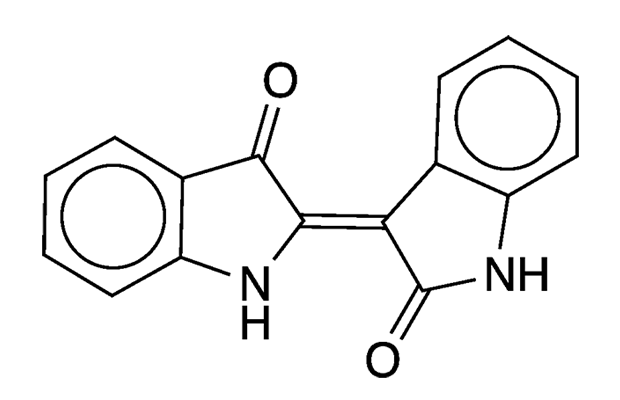What molecule am I?


Indirubin, an indigo dye, is a biomolecule found in the African and Asian shrub Indigofera arrecta. It is variously known as indigo red; indigo naturalis; qing dai; or Natal, Bengal, or Java indigo. It is also bacterially produced in the urine of humans and other mammals.
I. arrecta has been used as a folk medicine in Africa and Asia for centuries. In particular, Congolese healers use it in combination with other herbs to treat epilepsy. Indirubin itself shows biological activity and has been studied as a treatment for diseases ranging from cancers to colitis.
Recently, a consortium of researchers in Belgium, Tanzania, and the Democratic Republic of the Congo, led by Najat Aourz at Vrije Universiteit Brussel, became interested in how the Congolese herb cocktail controls epilepsy. Using zebrafish larvae as an epilepsy model, they deduced that indirubin is the ingredient that protects the larvae against chemically induced seizures. Indirubin similarly prevents induced seizures in rats and mice.
The researchers then sought to identify the protein that indirubin blocks to inhibit seizures. The culprit turned out to be glycogen synthase kinase-3, an enzyme that the body uses to regulate energy storage. The exact mechanism by which indirubin disables the enzyme has not yet been established.
Indirubin hazard information
| GHS classification*: skin corrosion/irritation, category 2 | |
| H315—Causes skin irritation | |
| GHS classification: serious eye damage/eye irritation, category 2A | |
| H319—Causes serious eye irritation | |
*Globally Harmonized System of Classification and Labeling of Chemicals. Explanation of pictograms.
Indirubin fast facts
| CAS Reg. No. | 479-41-4 |
| Empirical formula | C16H10N2O2 |
| Molar mass | 262.26 g/mol |
| Appearance | Red to deep purple crystals or powder |
| Melting point | 204–205 ºC |
| Water solubility | 35 mg/L (est.) |

Learn more about this molecule from CAS, the most authoritative and comprehensive source for chemical information.
Molecule of the Week needs your suggestions!
If your favorite molecule is not in our archive, please send us a message. The molecule can be notable for its current or historical importance or for any quirky reason. Thank you!
Stay Ahead of the Chemistry Curve
Learn how ACS can help you stay ahead in the world of chemistry.

